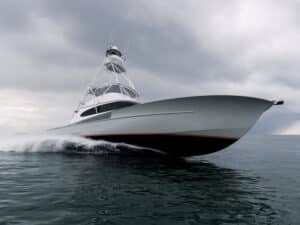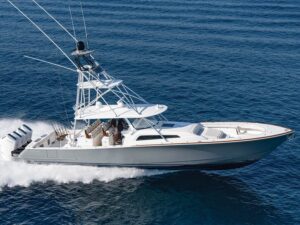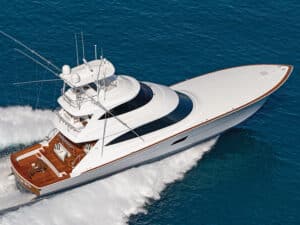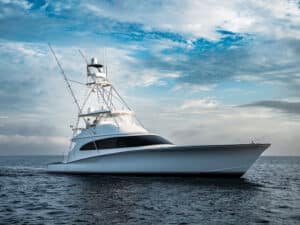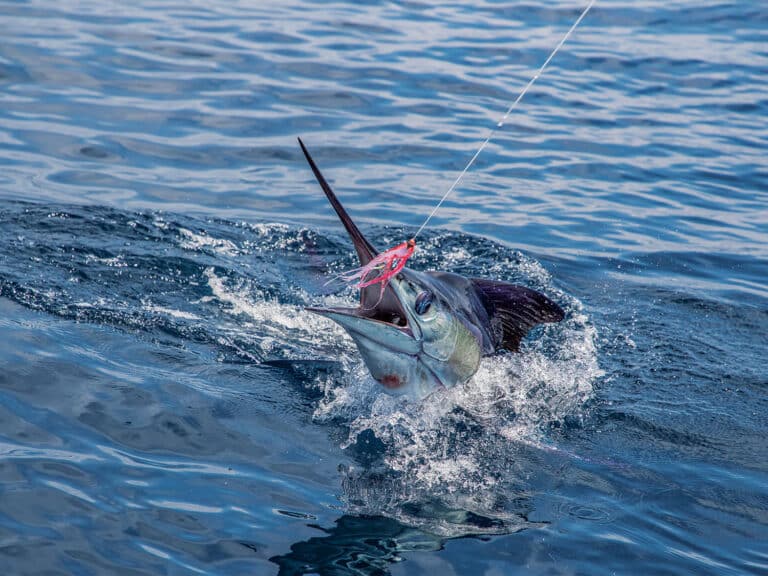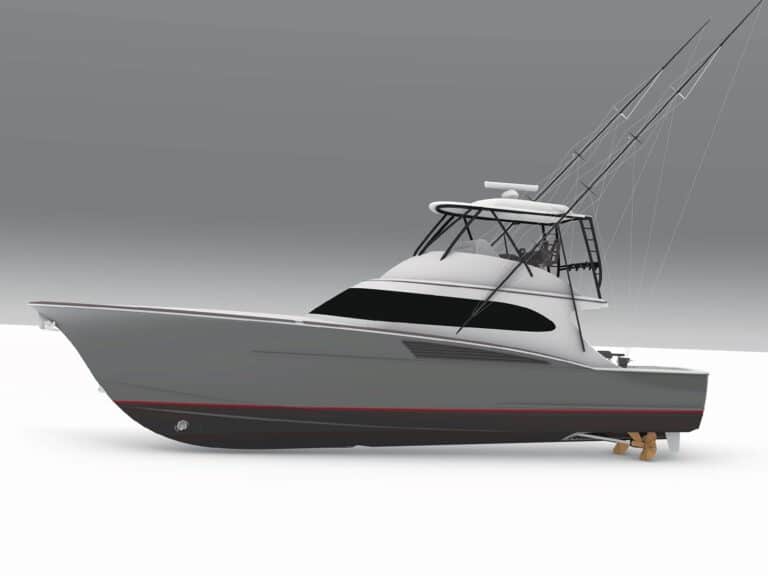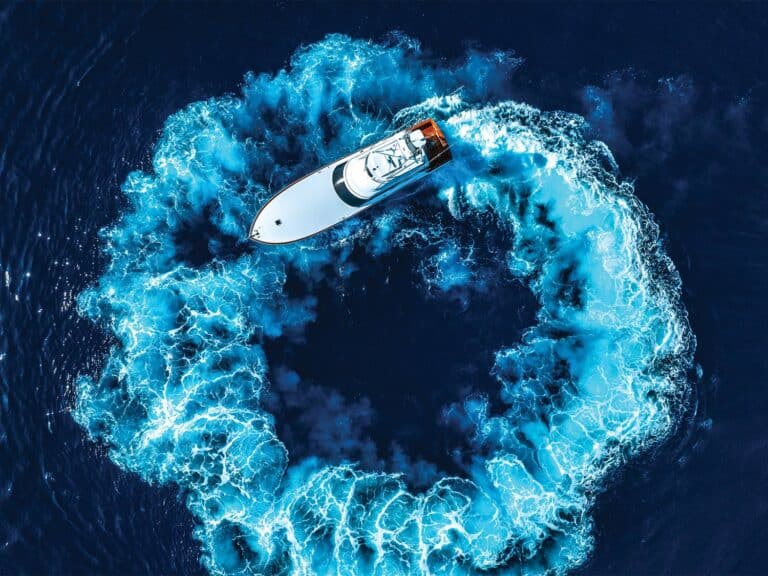It has been said that the process of designing a boat can best be described with the word “compromise.” If that is true, then Viking’s flagship 72 SF – the company’s newest and largest hull to date – must be a compromise between a 40-foot sportfisherman and a 130-foot luxury yacht. The only problem is, it’s kinda hard to find the areas that Viking compromised on to reach this impressive balance.
Certainly, the well-equipped bait-prep center and 216-square-foot cockpit provides plenty of room for the fishing. And no other boat in this class offers such luxurious features as a spiral staircase leading from the salon to the enclosed bridge and a full-width master stateroom amidships.
Last winter, we had the opportunity to fish hull No. 3 – a dealer boat still bristling from the factory – off the coast of Fort Lauderdale with HMY Yacht Sales’ Capt. Richard Coolbaugh and mate Mike LaFleur. While the sailfish failed to cooperate with our kite flying efforts, we did see enough to convince us that this hull will bring the 70-foot size range credibility as a legitimate platform for luxurious sport fishing.
Belowdecks
Styling on the 72 is typical Viking: conservative color schemes with plenty of the unrivaled teak woodwork that Viking is famous for. The centerpiece of the salon is undoubtedly the spiral staircase leading up to the bridge. This staircase is designed so well to be non-intrusive (you hardly notice it at all up on the bridge), it’s easy to forgive its 18-inch width and somewhat steep ascent.
Headroom in the main salon is 7’0″, which is reduced to 6’5″ for the galley level. The two steps up to this level provide additional headroom for the full-beam master stateroom directly below. This owner’s suite, one of the largest I’ve seen until getting up to the 80-foot class, features a king-size bed, extra-wide head with double vanity and extra-large his-and-hers cedar closets.
The 72 also boasts sleeping accommodations for six guests in the three additional staterooms, each with its own entertainment center, head and shower. A day head just forward of the dinette keeps wet and dirty anglers out of the forward staterooms. And one last interior feature that cannot go without mentioning is the 72’s incredible amount of dry storage space. Two air-conditioned closet-size pantries forward of both the galley and dinette are accessible from galley level and should store enough provisions to take full advantage of the boat’s long-range capability.
Flybridge
The enclosed flybridge on hull No. 3 features blacked-out windows with rounded corners. These windows, combined with the radiused design of the structure, gives the boat a sleek look from the water. Inside the flybridge are two solid Stidd helm chairs, a comfortable settee for six guests and a starboard bench seat that faces forward and seats two additional guests.
The electronics console will house any combination of navigation and fishing electronics, with room to spare. Visibility forward is excellent from the raised chairs, though when docking or fighting the fish, the skipper will have to leave his “apartment” and run the boat from a second control station aft of the bridge house.
Fishability
Because our test boat was not yet fully rigged (no outriggers, chair, rocket launchers or leaning posts), our day of fishing gave less than a complete picture of the boat’s fishability. One thing was certain, however: This boat’s cockpit is huge. We measured 12.5 feet in length and almost 15 feet in width, not including the bait-prep cabinets or the area under the coaming. This leaves 187 feet of the 216 total as empty, usable space.
The bait-prep center features a large freezer, sink with salt water and two banks of small tackle drawers. A starboard cockpit locker holds a Mathers MicroCommander with a 60-foot leash for full control of the boat from virtually anywhere on board. The transom houses a recirculating baitwell, which proved more than roomy enough for our two dozen goggle-eyes.
There are only two hatches in the cockpit – one dogged lazarette hatch and one fish box that runs nearly full width. Both areas are plenty big, and the lazarette provides easy access to the rudders and bilge. The coaming height in the cockpit was very comfortable, with knees hitting well below the gunwales.
At a trolling speed of 8 knots, the two 38-inch five-blade props put out a decent amount of white water, but the alleys cleared significantly only 15 feet behind the boat. Trolling on only one engine reduced the prop wash greatly. If slow trolling live baits is more up your alley, you’ll appreciate the trolling gears that come with the electronic controls for the twin 1,800-hp Duetz MWM engines.
Engine Room
Inside the engine room, the generous 6-foot headroom at centerline revealed a nicely illuminated and well-thought-out compartment. Access to all systems, even outboard, was more than generous, and immediately flanking the entrance are two Westerbeke gensets with workbenches above. The engine room air-conditioning system makes the compartment comfortable only an hour after returning to dock.
All wiring is bundled in plastic extruding channels mounted on the bulkheads and overheads, or even better, below the sole’s removable aluminum panels (18 inches from sole to hull surface). These panels all have plastic, non-corrosive latches to hold them in place, yet provide easy removal for off-boat cleaning.
All systems were clearly labeled and neatly plumbed and/or wired. Wire ends were nicely soldered and shrink-wrapped and plumbing fittings were cleanly done. One nice touch was the labeling of the seacocks. The electrical distribution panel and oil transfer panel were nicely labeled and user-friendly as well.
Engine installation, thanks to Viking’s unique steel-beam engine beds, was neat and simple. The overhead panel with gauges, alarms and shutoffs was nicely built with no sharp corners to surprise your head. Engine room ventilation was good via very large air intakes through the hull side, which redirect the incoming air three times before it enters the room – virtually eliminating saltwater mist intrusion.
Construction
The 72 represents somewhat of a break from the norm for Viking. Though the company has made use of vacuum-bagging and light-weight cores in its topsides for many years, this boat is the first to use coring below the waterline.
However, even in this attempt to lower the hull’s weight (120,000 pounds), Viking retains hull strength as the top priority. On the 72, Viking uses the light-weight core only in selected sections in the hull bottom. The company still uses only solid glass for any area which will receive a thru-hull fitting, bolt, strut, etc.
Performance
Running the boat to and around the fishing grounds was a pleasure. A mild 2- to 4-foot swell with about a 1-foot chop was running. We cruised at nearly 28 knots (1,900 rpm) with a third-load of fuel. We experienced no pounding whatsoever when heading into the head seas, and she tracked true in quartering or following seas. Drifting in a beam sea, the boat was stable with no snap rolling and no chine slapping. Only in the extra-high flybridge did you feel the effects of the beam swells.
The running angle of the 72 was low, so low in fact that she sent an occasional bit of spray over the bow – of little consequence when you have windshield wipers, but enough that you’ll want to retract the tabs when her forward tanks are full. (Thanks to the centerline fuel tanks, trim tabs are only needed for transverse leveling.)
Exhaust noise is very low, both at idle and at speed, but the boat did have some propeller noise, as you might expect when pushing big, overpitched props.
Even though it wasn’t really fair to do so, we backed the 72 as if she really was that 40-foot sportfisherman, and the boat’s agility surprised us. She backed well – and fast – in all directions. If help was needed to make a sharp turn in reverse, a simple push from the forward thruster was sufficient. When we put a swell over the transom, we appreciated the positive buoyancy created by the somewhat high cockpit deck, though we did have to open the cockpit door to help the scuppers handle the flood.
After our test day, I have no doubt about this boat’s ability to fish well. If, that is, you can get your skipper out of the enclosed bridge long enough to work up a sweat.
